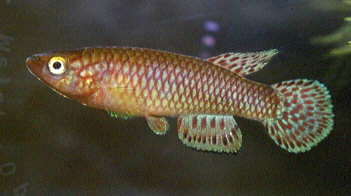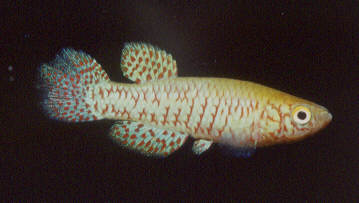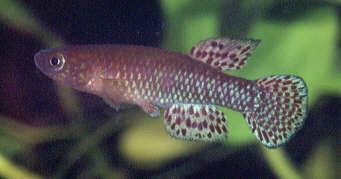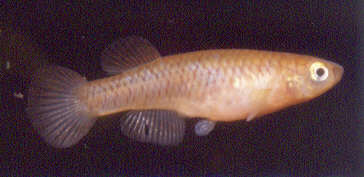Aphyosemion bamilekorum Radda 1971
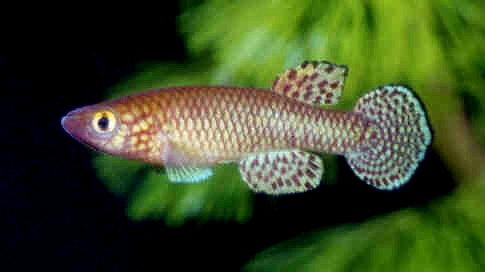
A.bamilekorum collected at type locality. Wild male. Photo Courtesy of Ed Pürzl
| Meaning of Name |
After the Bamileke, a tribe in Cameroon from the area of collection. |
||||||
| First Description |
Radda A.C. 1971. Cyprinodontidenstudien im südlichen Kamerun 5, Das Wald- und Grasland im westlichen Kamerun. Anhang: Vorläufige Beschreibung von Aphyosemion bamilekorum nov. spec. Aquaria 18: 177-181 figures 5-6. |
||||||
| Size |
Males 4cm, females 3·5cm. |
||||||
| Meristics |
D = 12, A = 15, D/A = 1 /5-7, ll = 27(+2). (Radda 1971) D = 13-14, A = 16-18, ll = 27-28. (Radda & Purzl 1983) |
||||||
| Karyotype |
17 (32) |
||||||
| Sub-Genus |
Formerly in Kathetys. Considered by many to be seperated from this subgenus. |
||||||
| Group |
A.exiguum (they may be in a group of there own in future). |
||||||
| Synonyms |
None |
||||||
Populations
Ref: KCF website |
|
||||||
| Type Locality |
Mifi, upper Noun in the Sanaga River system 9 km northwest of Bafoussam on the road to Bamenda. |
||||||
| Distribution |
The range of A.bamilekorum is restricted to the highland area between Bakoussam & Mbouda. This area is situated on the western boundary of the range of it's clos relative A.bualanum. Compared to the range of A.bualanum & A.exiguum from this group the range of A.bamilekorum is very small. |
||||||
| Habitat |
This is a sp. which has adapted to life in cool, fast running mountain brooks. Various expeditions have collected them under overhanging vegetation at stream banks at different times of the year & have found the water temperature to vary between 18-20°C, pH 5·8-7·0, DH 1-3. Savannah plateau (Bamileke) at 1,000m altitude. Another location being a highland brook 2km south of Mbouda near the road between Bafoussam & Bamenda had a depth of 10-50cm & was running quite fast. Water temperature readings on different dates were :-
|
||||||
| Distinguishing Characteristics |
Body shape, which is unlike any other forms of Aphyosemion. Also, all the un-paired fins contain spots which are sometimes joined to form lines which radiate outwards. Specimens collected to the west of Bafoussam show this radiating of lines to a greater extent than those collected to the east. Un-paired fins do not outer margins as is so distinctive with most Aphyosemion sp. |
||||||
| Colour/Pattern Variability | Low | ||||||
| History |
Described by A.C.Radda in 1971. Although the area which this sp. inhabits is mountainous, they have still been collected on a number of occasions in 1972 - 1973 & on the Chauche / Poliak trip of 1982. Radda collected them on February 11, 1977. In 1972 another form of this sp. was found in a highland brook 2km south of Mbouda near the road from Bafoussam to Bamenda. These wild fish differed from those collected in the type locality but the next generation appeared to be identical with those collected at the type locality. |
||||||
| Breeding Notes |
Not one of the easier Aphyosemion sp. to breed. Good results have been reported using peat fibre which has sunk to the base of the tank. The spawning tank should be filled with rain water. Parents may be left together in a permanent breeding set-up, taking out any fry which appear. A Dutch breeder also put branches of wood & Java moss into the breeding tank. Also the pair can be seperately conditioned & placed together in a breeding set-up for two weeks after which time they can be taken out leaving the eggs to hatch in safety. Males can be aggressive. They are very infrequent egg layers I found, so numbers of fry can be expected to be low. Eggs incubate for 14 - 21 days in water. Experiments have shown that eggs can be incubated on damp peat for one month. On hatching the fry can take newly hatched brine shrimp & microworm. Growth is slow with sexing out taking as long as 12 months, although they have reportedly reached sexual maturity at 8 months. Spawning this sp. stands a better chance of success if you use fish which are at least 12 months old. The youngsters are very slow growing. A breeding report was written in BKA newsletter
no.152, April 1978 by Paul Berat who used cool water of 18·5
- 20·5°C (this was considered important). Hardness &
pH were not regarded as important. Egg production was slow with only
batches of 10 fry with a high proportion of belly sliders. A French breeder noticed fry to belly slide if kept below pH 7. He also observed 21°C was best for breeding. |
||||||
| Diameter of Egg | 1 - 1·2mm | ||||||
| Remarks |
This is an oddball sp. which may represent a remnant of an ancient group of fish possibly containing Nothobranchius. I spawned the Bafoussam population in water with a temperature of 70-72°F with a DH of 10 & a pH between 7·0 - 8·0 & found them quite prolific. This is quite different to there natural water. This sp. can be sensitive to build ups of dissolved metabolic wastes & regular water changes should be performed. |
